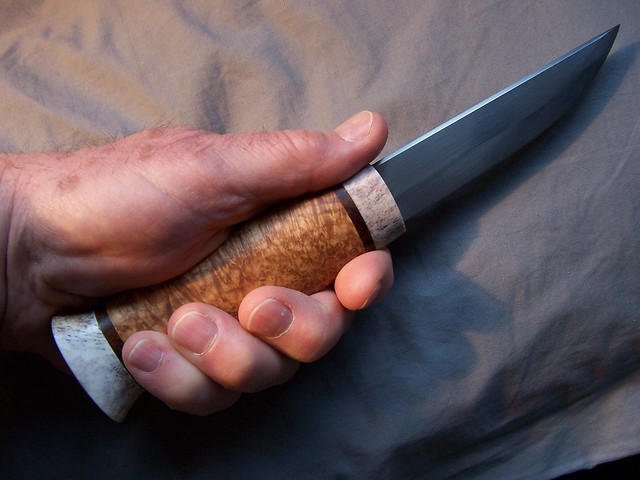-
The BladeForums.com 2024 Traditional Knife is available! Price is $250 ea (shipped within CONUS).
Order here: https://www.bladeforums.com/help/2024-traditional/
You are using an out of date browser. It may not display this or other websites correctly.
You should upgrade or use an alternative browser.
You should upgrade or use an alternative browser.
The Puukko
- Thread starter t.sous11
- Start date
- Joined
- Jun 27, 2007
- Messages
- 8,255
Here is one from Veikko Hakkarainen



Something about this knife just speaks to me - I keep coming back to admire it.
I wish to own one like it in the future.
Does this count as that style?Production finally up and running again. Based on the Sami style, this puukko is my interpretation. Blade 117x22mm remachined and ground from a Lauri 120mm stainless little Leuku blade. Spine was beveled and blade polished to 800x satin finish. Handle is black ash burl with contrasting desert ironwood spacers and dense deer antler bolster and caribou bone endcap. Danish oil finish applied and wet sanded to 1000x. Sheath will be smooth black buffalo leather with dangler.
][/url][
]
]/158694019@N03/]

You recognize a puukko when you see it. No need to define what it is."Scandi" grind is ok on knives 2mm or less,traditional puukkos all have at least 2/3 grind with convex or secondary edge bevel.I regrind all my moras and make grind higher and put secondary on them,and they perform way better for any task.Old clippers from mora and 2mm and less are pretty good with this scandi grind,but blades od 4,5,6mm with this grind are ridiculous in my opinion and just a fad or way to save money on grinding.
Puukko by my definition: knife made preferably by hand, not industrial, to be used and durable by ages. Some are for show.Agreed, but it is often necessary. Words have meaning, and using words carelessly robs them of those meanings. That's how we end up with the odious use of the term wharncliffe to describe the blade on the Benchmade Immunity.
Plastic very much frowned upon. Don't try it.
Last edited:
I think the proper term here is Unna niibaš or Buiku if thats a Sami made knifeDoes this count as that style?

"Salvaged some trash"I think the proper term here is Unna niibaš or Buiku if thats a Sami made knife
I think the proper term here is kiitos.
Last edited:
I think the proper term here is Unna niibaš or Buiku if thats a Sami made knife
Hi! Don't stitch too close to the edge. A Puukko has no use without a sturdy seath.
I know by now.No need to tellhawkhead how to make his puukkos and sheaths. He's got this.
Thats is the way its done and always has been done by the best.....Its not a problem with the right materials.Hi! Don't stitch too close to the edge. A Puukko has no use without a sturdy seath.
Its generally not sewn close to the edge. Its sewn first then trimmed close.
Just a few examples-
Vintage Jarvenpaa

Pawel Michalski

Vintage Kustaa Lammi

Veikko Hakkarainen

Zhelyo Tenev

Can youNo need to tellhawkhead how to make his puukkos and sheaths. He's got this.
Can't argue, and what I needed to see again. What more do you want me to say?Thats is the way its done and always has been done by the best.....Its not a problem with the right materials.
Its generally not sewn close to the edge. Its sewn first then trimmed close.
Just a few examples-
Vintage Jarvenpaa

Pawel Michalski

Vintage Kustaa Lammi

Veikko Hakkarainen

Zhelyo Tenev

They may look the same, but they are not the same.My first puukko...Have owned the typical Moras but never a puukko...not disappointed...

But vuolupuukko is short and don't have "veriura".Yeah my guess would be for wood carving of some sort. All the examples I have come across have the hooked pommel (vaan koukulla I think is the term used in the old catalogs) usually found on vuolupuukkot.
I took a quick look around the internet and found two more similar examples of curved handle knives. I don't think these all somehow just got bent in the exact same manner......


I asked four Finnish knife collectors I know. None of them had seen such handles in catalogs. Such knives can be found at Finnish flea markets. This is due to the thin and soft tang of the blade. And if you wet the birch bark, it swells and the cracks disappear. The sheath you showed above is not original. It was made by the owner later, when the knife was already deformed. Knives with such handles were not produced by manufacturers.
Congrats on owning that blade.Puukko from Wood Jewel is on my walk today.


The Suomi series is dedicated to the centenary of Finland's independence.


I went to Marttiini store today in Santa’s village. Their newish carbon leuku was tempting but it is a bit light for leuku and I have asked santa for heftier leuku.




















